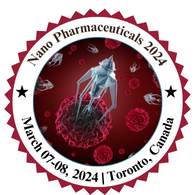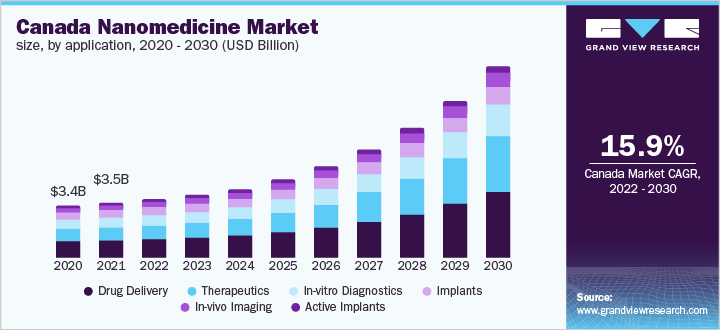Sessions and Tracks
Track 1: Nanoparticles and Nanomedicine
Nanotechnology, the manipulation of matter on the nanoscale, has revolutionized various fields, with nanomedicine standing out as one of its most promising applications. Nanoparticles, tiny structures ranging from 1 to 100 nanometers in size, have garnered immense attention for their potential to transform the diagnosis, treatment, and prevention of diseases.
Nanoparticles are the unsung heroes of the nanomedicine revolution. They can be engineered from a wide array of materials, including metals, polymers, and lipids, each offering unique properties for targeted medical applications. Their small size gives them a high surface area-to-volume ratio, making them ideal for drug delivery, imaging, and diagnostics.
Nanomedicine is an emerging field of science and technology that harnesses the unique properties of nanoparticles to revolutionize healthcare. With the ability to manipulate matter at the nanoscale, scientists and medical researchers are exploring novel ways to diagnose, treat, and prevent diseases more effectively and with fewer side effects than traditional methods.
Track 2: Pharmaceutical Nanotechnology
Pharmaceutical nanotechnology is an emerging field at the intersection of pharmaceutical science and nanotechnology. It is the exciting, rapidly emerging branch of medical science that deals with harnessing nanoscale materials as drug delivery and/or diagnostic tools. As drug delivery tools, nano-delivery systems can be used to enhance the site-specific, targeted delivery of precise medicines. The drug delivery system positively impacts the rate of absorption, distribution, metabolism, and excretion of the drug or other related chemical substances in the body. Pharmaceutical nanotechnology embraces applications of nanoscience to pharmacy as nanomaterials, and as devices like drug delivery, diagnostic, imaging and biosensor.
Pharmaceutical nanotechnology represents a paradigm shift in drug delivery, diagnosis, and therapy. The ability to manipulate matter at the nanoscale opens up new possibilities for precision medicine, early disease detection, and innovative therapies. However, this field also faces challenges related to safety, regulation, manufacturing, and ethics.
Track 3: The Evolution of Nanomedicine with the Re-Evolution of Nanotechnology
Although nanotechnology seems to have gained a widespread interest in the recent years, the concepts behind nanoscience and nanotechnology are dated back to 1959 when physicist Richard Feynman delivered a talk entitled ―There‘s Plenty of Room at the Bottom‖ at an American Physical Society meeting at the California Institute of Technology (CalTech). However the term 'nanotechnology' was coined over a decade later, by Professor Norio Taniguchi, in his explorations of ultraprecision machining. In 1981 as the scanning tunneling microscope developed, the evolution of nanotechnology began to turn out today as a revolution in the fields of engineering and technology, imaging, measuring, modeling, and manipulating matter nanoscale.
The medical application of nanotechnology is widely termed as nanomedicine. It ranges from medical applications of nanomaterials to nanoelectronics biosensors. The research and development of nanomedicine is broadly divided into three factors.
-
The first impact of nanoscience on medicine is evolutionary.
-
A second development is explicit and revolutionary, emphasizing great advances to be gained by radical new nanotechnology approaches.
-
A third source of nanotechnology on medicine is indirect through the development and application of ever-improving nanotools and devices based on smaller and more precise technologies.
Track 4: Nanomedicine and Nanobiotechnology
Nanomedicine and Nanobiotechnology is a branch of engineering that involves the development and application of materials and devices to study biological processes and to treat disease at the level of single molecules and atoms. It also involves manipulating materials at the nanoscale to achieve superior performance in the diagnosis, prevention, and treatment of disease.
-
Drug Delivery
-
Imaging
-
Diagnostics
-
Regenerative Medicine
-
Personalized Medicine
Nanobiotechnology combines nanotechnology and biotechnology to create innovative tools and applications for biological research, diagnostics, and therapeutics.
-
Biomolecular Engineering
-
Biosensors
-
Drug Development
-
Biological Imaging
-
Tissue Engineering
-
Ethical Considerations
Track 5: Nanorobotics and Nanomedicine
Nanomedicine will be based on the ability to build Nanorobots. In the future these Nanorobots could actually be programmed to repair specific diseased cells, functioning in a similar way to antibodies in our natural healing processes. The motivation for the new manipulation technology is the desire to enter the micro and Nanoworld not only by viewing but also acting, altering micro- and nanosized objects. A new era on medicine are expected to happen in the coming years. Due to the advances in the field of Nanotechnology, Nanodevice manufacturing has been growing gradually. The elimination of bacterial infections in a patient within minutes, instead of using treatment with antibiotics over a period of weeks.
Track 6: Smart Drug Delivery Technology
The development of the smart drug delivery system (SDDS) is a revolution of nanotechnology in the pharmaceutical and medical fields. Nanomaterials through their enhanced target specificity, biodistribution, and plasma retention have overcome the therapeutic adverse effects of the conventional drug delivery system. The response-based intelligence of the system helps to release drug payloads released under specific pathological conditions. The development of an intelligent drug delivery system combines multiple approaches and multiple signal responses to improve their applicability in diagnosis as well as therapy.
Track 7: Computational Studies in Nanoparticles
The computational studies in nanoparticles have demonstrated that there has been considerable progress in Nano and biotechnology in the last several years. However, several key challenges have also become apparent, including the need for a better understanding of nanoparticle behaviour in vivo and the development of more effective nanoparticle therapeutics. Computational efforts are becoming an important tool in addressing both of these challenges, as well as in generally facilitating and accelerating nanotechnology-based translational research. The Nanoinformatics has come out as a new research area that covers raw data management, analysis of the data derived from biomedical applications and simulation of nanoparticle interactions with biological systems depicting the integration of biology, nanotechnology and informatics to form the basis for computational Nanomedicine.
Track 8: Research and Development of Nanomedicine
Nanomedicine has been developing rapidly in recent years, particularly in the development of novel Nano tools for medical diagnosis and treatment. For instance, a new trend is becoming prevalent in developing Nanosystems for simultaneous tumour diagnosis and therapy. A new terminology "Theranostics" has been frequently used and applied in pre-clinical research and trials. A Nanosystem can simultaneously achieve both cell targeted in vivo imaging and photothermal treatment of cancer. While achieving concurrent high spatial and temporal resolution of the lesions via cell targeting; special non-evasive treatments are implemented at the same time by various means, such as localized drug release, hyperthermia, and photo-thermal therapy. Inspired by these challenging problems in biomedical fields, the development of the nanotechnologies will be the key in addressing some of the critical issues in medicine, especially in early cancer diagnosis and treatment.
Track 9: Nanoparticles As Precise Drug Delivery Systems
With the remarkable development of Nanotechnology in recent years, new drug delivery approaches based on the state-of-the-art nanotechnology have been receiving significant attention. Nanoparticles, an evolvement of nanotechnology, are increasingly considered as a potential candidate to carry therapeutic agents safely into a targeted compartment in an organ, particular tissue or cell. These particles are colloidal structures with a diameter less than 1,000 nm, and therefore can penetrate through diminutive capillaries into the cell’s internal machinery. This innovative delivery technique might be a promising technology to meet the current challenges in drug delivery. The different types of nanoparticles drug delivery systems under investigation and their prospective therapeutic applications, and also present a closer look at the advances, current challenges, and future direction of nanoparticles drug delivery systems.
Track 10: Polymer Nanoparticles for Nanomedicines
The use of nanoscale materials and processes to address human disease is perhaps the most promising, considering that most complex downstream symptoms of disease are initiated by molecular level phenomena. Nanomedicine is defined as biological and medical intervention at the nanometer scale for the treatment, diagnosis, and increased understanding of biology and disease. Tremendous advances in the area of polymer synthesis and self-assembly have given rise to a new toolbox of engineered nanosized delivery and diagnostic agents that permit systemic and local administration, circulation in the bloodstream, and uptake and diffusion at the cellular and subcellular level.
Track 11: Design and Characterization of Nano Drug Systems
Recent years have witnessed the rapid development of inorganic nanomaterials for medical applications. At present, nanomedicines-nanoparticles (NPs) destined for therapy or diagnosis purposes-can be found in a number of medical applications, including therapeutics and diagnosis agents .Pushing the limits of nanotechnology towards enhanced Nanomedicines will surely help to reduce side effects of traditional treatments and to achieve earlier diagnosis. The interplay between engineered nanomaterials and biological components is influenced by complex interactions which make predicting their biological fate and performance a nontrivial issue. We hope that both early-stage and experienced researchers will find it valuable for designing nanoparticles for enhanced bio-performance. Nanoemulsions have attracted great attention in research, dosage form design and pharmacotherapy. This is as a result of a number of attributes peculiar to nanoemulsions.
Track 12: Toxicology of Nanoparticles
Nanotechnology is a rapidly growing field having potential applications in many areas. Nanoparticles have been studied for cell toxicity, immunotoxicity, and genotoxicity. Tetrazolium-based assays such as MTT, MTS, and WST-1 are used to determine cell viability. Different types of cell cultures, including cancer cell lines have been employed as in vitro toxicity models. Considering the potential applications of NPs in many fields and the growing apprehensions of FDA about the toxic potential of Nanoproducts, it is the need of the hour to look for new internationally agreed, free of bias toxicological models by focusing more on in vivo studies. The rapid expansion of nanotechnology promises to have great benefits for society, yet there is increasing concern that human and environmental exposure to engineered nanomaterials may result in significant adverse effects. The system was developed for Nanotoxicity assessment at single and multiple cell levels which can measure and compare the microscopic and macroscopic effects of nanoparticles interaction with cells, without interference from neighbouring cells' cues and also overall integrative effects produced by nanoparticles and cell–cell communication.
Track 13: Emerging Nanomedicine
Currently, the treatment of HIV requires regular oral dosage of HIV drugs, and chronic oral dosing has significant complications that arise from the high pill burden experienced by many patients across populations with varying conditions leading to non-adherence to therapies. Recent evaluation of HIV patient groups have shown a willingness to switch to nanomedicine alternatives if benefits can be shown. Research efforts by the Liverpool team have focused on the development of new oral therapies, using Solid Drug Nanoparticle (SDN) technology which can improve drug absorption into the body, reducing both the dose and the cost per dose and enabling existing healthcare budgets to treat more patients.
Track 14: Pharmaceutical Formulations
Formulation studies involve developing a preparation of the drug which is both stable and acceptable to the patient. For orally administered drugs, this usually involves incorporating the drug into a tablet or a capsule. It is important to make the distinction that a tablet contains a variety of other potentially inert substances apart from the drug itself, and studies have to be carried out to ensure that the encapsulated drug is compatible with these other substances in a way that does not cause harm, whether direct or indirect. Formulation studies also consider such factors as particle size, polymorphism, pH, and solubility, as all of these can influence bioavailability and hence the activity of a drug.
Track 15: Applied Pharmaceutical Science
Pharmacy is the science and technique of preparing and dispensing drugs. It is a health profession that links health sciences with chemical sciences and aims to ensure the safe and effective use of pharmaceutical drugs. A theory relating chemical structure to pharmaceutical activity emerged from the interplay of experimental results from animal and human tests using vaccines, antitoxins, and antibodies with chemical knowledge about dyes and their molecular structures. Although pharmacology is essential to the study of pharmacy, it is not specific to pharmacy. Pharmacoinformatics is considered as another new discipline, for systematic drug discovery and development with efficiency and safety. The progressively more important role of the chemist and chemical science in pharmaceuticals in the early-20th century is mirrored in the history of the American Chemical Society's Division of Medicinal Chemistry.
Track 16: Nanobubble in Nanomedicine
In recent times, microbubble and Nano bubble technologies have drawn great attention due to their wide operations in numerous fields of wisdom and technology, similar as water treatment, biomedical engineering, and nanomaterials. Nano bubbles parade unique characteristics; due to their nanosecond size and high internal pressure, they can remain stable in water for dragged ages of time. Nanobubbles can be created when gold nanoparticles are struck by short ray beats. The short- lived bubbles are veritably bright and can be made lower or larger by varying the power of the ray. Because they're visible under a microscope, nanobubbles can be used to either diagnose sick cells or to track the explosions that are destroying them.
Track 17: Nanosurgery
The main current operations of Nanotechnology for surgeons are in the areas of development of surgical implants using Nanomaterials, Imaging, Drug Delivery and development of Towel Engineering products, similar as pulpits with enhanced material – cell commerce. An illustration of this is the development of a altar for delivery of stem cells to replace imperfect retinal pigmented epithelial cells in age- related Macular Degeneration. In Dentistry exploration has been done, liposomal Nanoparticles that contained collagenase and performed tests with them in rats, and set up compared to conventional surgery, collagenase weakened the collagen filaments, making it easier to shift the teeth subsequently with braces.
Track 18: Nanotechnology in Biology
Nanotechnology is enabling technology that deals with Nano- cadence sized objects. It's anticipated that nanotechnology will be developed at several situations accoutrements , bias and systems. The combination of biology and nanotechnology has led to a new generation of Nano bias that opens the possibility to characterize the chemical, physical, mechanical, and other molecular parcels. And it can be indeed used to characterize the single motes or cells at extraordinarily high outturn. Nanoparticles with distinctive chemical compositions, sizes, shapes, and face chemistries can be finagled fluently and this fashion has wide range of operations in natural systems. mileage of nanotechnology to biomedical lores indicate creation of accoutrements and bias designed to commerce insub-cellular scales with a high degree of particularity.
VISA-Trip Advisor
An issue with VISA!!
Nano Pharmaceuticals Committee will be happy to help you in all regards to plan your trip to Toronto, Canada. Avail the official invitation letter from us to attend this event ahead with a closer step for approval of your VISA.
Find out what you need to do to visit
Canada as a tourist or business person, how to extend your stay in Canada and what documents you need to carry with you to transit through Canada.
Application submission:
Canada does not have a visa office in every country so it is important that Delegates/Attendees visit the website of the visa
office responsible for processing their visa applications. Information is available on the website on how to submit a visa application and the documentation required.
Delegates/Attendees are encouraged to submit their visa applications well in advance of the date of the event at a Visa
Application Centre or on-line
E-applications (e-Apps).
E-Apps
This system allows clients to submit applications online.
Delegates/Attendees that need a visa but require their passport for other travel purposes are strongly encouraged to submit their visa applications online (
e-Apps). Delegates/Attendees that choose to apply online will not have to submit their passport until a decision has been taken on their applications. If required, the visa office will send the applicant instructions on how and where to send their passports to finalize the visa process.
Visa Application Centres (VACs):
VACs are commercial service providers authorized by Canada to provide specific services to applicants.
VACs provide a number of services including help applicants fill out forms, answer questions and ensure that applications are complete, thereby reducing unnecessary delays or refusals due to incomplete applications.
VACs send applications to Visa Offices and transmit decisions to applicants in a secure and confidential manner. VACs do not process visa applications and play no role in the decision-making process.
Visa Applications Processing Time:
Processing time for visa applications vary depending on the office and the time of the year. Participants should be encouraged to apply early for their visas, and to submit complete applications including all supporting documents.
NEW - Electronic Travel Authorization (eTA)
As of March 15, 2016, visa-exempt foreign nationals are expected to have an
Electronic Travel Authorization (eTA) to fly to or transit through Canada.
Exceptions include U.S. citizens and travelers with a valid Canadian visa. Canadian citizens, including
dual citizens, and Canadian permanent residents are not eligible to apply for an eTA.
However, from March 15, 2016, until fall 2016, travellers who do not have an eTA can board their flight, as long as they have appropriate travel documents, such as a valid passport. During this time, border services officers can let travellers arriving without an eTA into the country, as long as they meet the other requirements to enter Canada. We invite you to consult the IRCC website regularly for information updates on eTA.













 The global nanomedicine market size was valued at USD 159.53 billion in 2021 and is expected to expand at a compound annual growth rate (CAGR) of 11.7% from 2022 to 2030. Development and commercialization of the techniques that holds potential to significantly improve the administration of drugs and disease management is expected to drive the adoption of nanomedicines in this market. Furthermore, growing adoption of nanotechnology-based drug delivery methods coupled with inefficiency of conventional therapeutics in disease treatment has driven the nanomedicine market growth.
The global nanomedicine market size was valued at USD 159.53 billion in 2021 and is expected to expand at a compound annual growth rate (CAGR) of 11.7% from 2022 to 2030. Development and commercialization of the techniques that holds potential to significantly improve the administration of drugs and disease management is expected to drive the adoption of nanomedicines in this market. Furthermore, growing adoption of nanotechnology-based drug delivery methods coupled with inefficiency of conventional therapeutics in disease treatment has driven the nanomedicine market growth. This report forecasts revenue growth at global, regional & country levels and provides an analysis of the latest trends in each of the sub-segments from 2020 to 2030. For this report, Grand View Research has segmented the global nanomedicine market based on the application, indication, molecule type, and region.
This report forecasts revenue growth at global, regional & country levels and provides an analysis of the latest trends in each of the sub-segments from 2020 to 2030. For this report, Grand View Research has segmented the global nanomedicine market based on the application, indication, molecule type, and region.